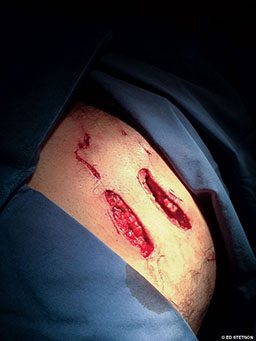The Diver
The diver was a 67-year-old male with 35 years of diving experience.
The Incident
Early one afternoon near La Paz, Mexico, at Los Islotes, a popular dive site and sea lion rookery, a sea lion bit the diver on the stomach. At the time of the attack he was scuba diving in less than 20 feet of seawater with approximately 50 other divers from several dive boats present. After the attack, fellow divers and the crew helped him back aboard the ship. They removed his 3mm wetsuit to assess the injury and control the bleeding. He was conscious and lucid the entire time.
The liveaboard arrived in the harbor approximately two hours later, just before 3 p.m., and the diver was transported ashore in a waiting panga boat. The crew had dressed and bandaged his wounds, and he was in good condition overall. The patient, trip leader and crew determined that waiting for an ambulance might delay transport (unfortunately ambulances in that area cannot always provide timely responses), and so the trip leader chose to drive the diver in his private vehicle.

During the drive, the diver’s vital signs were normal, and he did not show any signs of distress despite his obvious wounds. Because he appeared stable and the bleeding was controlled, they chose to go to a nearby local clinic. Area hospitals are usually quite busy with patients, possibly causing a delay in treatment for this diver.
They arrived at the local clinic just before 4 p.m., and the attending physician assumed care of the patient. The wounds were two parallel lacerations approximately 2 inches long, a half-inch wide and more than an inch deep with some smaller adjacent puncture wounds.
The doctor and his staff thoroughly cleaned the wounds, injected a local anesthetic and sutured the wounds closed. Two internal sutures were used first in each wound as they required a multilayer closure. Before he completed the closure, the doctor placed a sterile wick to promote drainage. One of the small puncture wounds required a single suture to close.
At the doctor’s direction, a nurse administered a tetanus booster. The diver was discharged around 6 p.m., and his traveling companions escorted him to his hotel.
Analysis
This incident is an excellent reminder of why dive operators need to have a preexisting emergency action plan and not hesitate to implement it. It also serves to illustrate that any action plan needs to accommodate emergencies beyond those involving decompression illness. For dive crew, good first-aid skills for physical trauma are a must.

The dive operator contacted local personnel who were familiar with local resources and made a decision based on their input and knowledge. The operator decided to transport the injured patient with the assistance of an EMT who was on the trip as well as a local lifeguard who was also an EMT.
Medical evaluation and treatment are important with any injury in which the skin is penetrated in the marine environment. Seal and sea lion bites in particular have a very high probability of infection. The importance of proper cleaning and disinfection cannot be overstated, even with apparently small wounds. All such wounds should to be monitored for signs of infection for at least seven to 10 days. Those signs can include increased swelling, pain or tenderness at or around the wound, increased redness, foul-smelling discharge from the wound, red streaks extending away from the wound site, fever and nausea.
Although it is not entirely clear why the sea lion bit the diver, a witness saw two bull sea lions fighting aggressively followed by one turning to flee from the other. The diver was approximately 50 feet away from them, but he was in the path of the fleeing animal and was bitten. Regardless of how playful or docile a marine animal may appear, we must not forget we are visitors to their environment and should remain keenly aware of their behavior. Be sure to learn how to observe and approach animals, and always follow experts’ recommendations.
Seal and Sea Lion Management
Contact with seals or sea lions can result in a serious infection by the bacterium leptospirosis, commonly known as “seal finger.” Avoid feeding seals, as this will significantly reduce the likelihood of seal/human contact. Prevent contact between dogs and seals; diseases can be transmitted between them.
Wash any wounds caused by seals or sea lions thoroughly with disinfectant, and dry them. Seek medical care for any injuries caused by these animals, as there is potential for serious long-term health implications. Be sure to tell the doctor you were bitten by a seal or sea lion. Watch carefully for unusual signs or symptoms for seven to 10 days, and go to the hospital if you feel unwell at any time.
© Alert Diver — Q1 Winter 2016